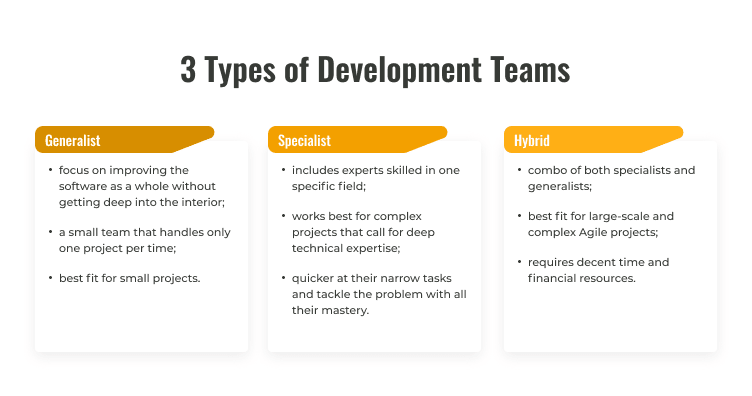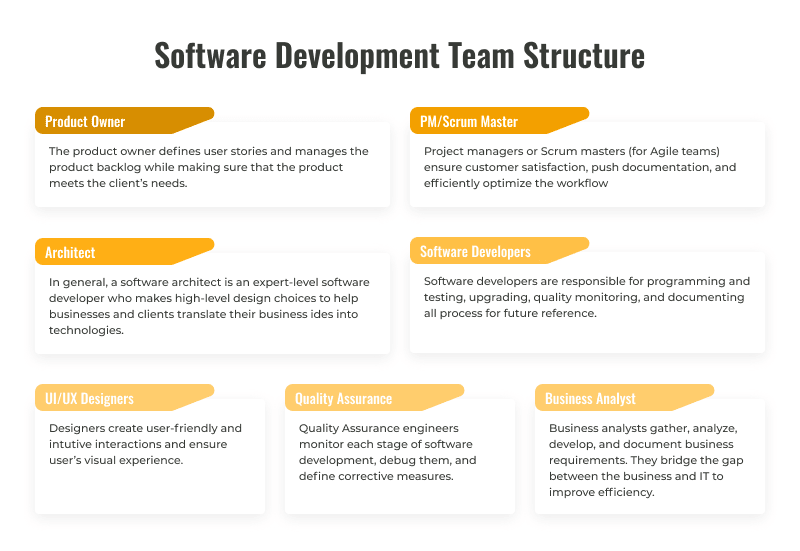Planning to launch an innovative digital product or working on a project that requires tech creativity? In both cases, the Agile approach and methods, like Scrum or Kanban, might be a solution for you. The Agile methodology allows you to make your development adaptive and responsive as it is built on thoughtful and frequent iterations instead of having a general working plan that remains unchangeable.
Understanding Agile methodology phases will help you to build a strong and creative team that can easily cope with advanced tasks concerning your product development. With this article, we’ll guide you through the systems development life cycle (SDLC) in terms of Agile and explain Agile team types, roles, and tools.
The Key Principles of Agile Development
In brief, the Agile software development life cycle is about staying flexible, transparent, and productive at every stage of your product development. Agile workflow is commonly divided into small sprints (up to 3 weeks) that finish with solid result delivery that one can evaluate as a whole. Examples of such sprint objectives: a new version of your product ready to launch or completed work on certain product features.
The key difference between classic software development and one based on the Agile methodology steps is that the Agile team doesn’t necessarily know where it is heading and what the final product or result should look like and what tools they are going to use to achieve them. Instead, they are focused on the continuous delivery of valuable software and results for their clients.
Agile methodology is based on 12 principles that work perfectly for small teams where it is possible to maintain constant communication (both formal and informal) between team members. The most important of them are the following:
- Flexibility across project execution
- Constant contact between client and team members
- Interaction-based software development with each iteration having its independent value
- Results are of primary importance (compared to tools)
The Agile approach has several proven advantages for development companies and their clients, including higher software quality, lower risks, and faster delivery. Moreover, it allows you to stay flexible with your budget and business objectives if necessary and provides a product your audience really needs by studying changeable market diagrams and statistics, as well as working hand to hand with the Agile team that can provide you with an alternative vision of your project.
Types of Software Development Teams
Agile product development requires a special type of team. In particular, the difference between this methodology and classic software development is that your team communicates intensively. This way, all team members are aware of each other's tasks, can help each other or exchange tasks if needed, which makes the most of their skills and professional superpowers.
As you already know, the Agile process flow is iterative. Moreover, with each new iteration, the roles of your creative team members may change slightly, depending on the goals of the next sprint. Projects that are based on Scrum (which is an Agile methodology) can be carried out by these types of Agile teams:
Generalist
best for — small projects with the clear and simple tech stack
Such a team consists of universal soldiers who can perform a wide variety of tasks related to software development, transfer them to each other, and at the same time have a clear view of the big picture. Teams like this do well on small projects with a clear tech stack.
Specialist
best for — innovative and niche projects
Members of this team are experts in different technical or creative areas. They are capable of performing tasks of advanced complexity or suggesting creative solutions. The team excels at developing innovative products and complex software architectures. They can also be more attentive to detail and point out product flaws in the context of their expertise.
Hybrid
best for — any type of project including complex ones
In a hybrid Agile team, there are specialists and generalists who reinforce each other's effectiveness. This team model allows you to achieve a high-quality product, as well as save money in areas that do not require exceptional expertise.
Roles in Agile Software Development Teams
The Agile concept is based on the idea that the more flexible and transparent the workflow is, the better it is for the product quality, budget, and timelines. As we noted, Agile team members can take on a variety of tasks, help each other, and make decisions on the go. At the same time, the Agile system development life cycle is possible only with a clear distribution of roles within the development sprint. These are the basic roles in an Agile team:
Product owner
This person has a general vision of the project, including how the product will be useful to future users. It can be the representative of the contracted software development company or someone from the company itself if it is a product company. The product owner makes sure their product contains all features that users might need.
Project manager (team lead, scrum master)
This person plans the team's work, organizes communication sessions, tracks progress, and maintains project documentation. They can also streamline workflows and serve as a link between the customer and the development team.
Architect
This is a highly qualified expert who is responsible for the technical architecture of the future product. It involves high-level design choices, linking the needs of future users of your product, the client's requirements, and the technical (technological) aspect of the product.
Software developer
This team member is responsible for the task directly related to the development, testing, and quality monitoring of the software. Software developers create programs based on the requirements and vision of the software architect. One project can have several developers of different skill levels.
Designer
This category includes both UI designers and UX experts. They are responsible for making the interface of the future product clear and convenient for users, as well as making the product look appealing and stylish. These people are constructing the visual experience.
Tester
At the implementation phase in SDLC, it is important not only to create software but also to make sure that it works correctly. This is the task of QA (quality assurance) engineers. They evaluate the quality of technical and design solutions at every stage of engineering, including the final one, and draw up a list of necessary improvements.
Business analyst
Not every Agile team has its own BA, but having such a person in the team helps to reduce the risks associated with the future business. This specialist studies product demand and market activity to help the team deliver a competitive and cost-effective product.
Agile teams are usually small (up to 10 members) and some team roles might be executed by the same team members. They can also switch roles if some of them have deeper expertise in certain areas. Learn more on hiring experts for your project here — How to Hire Dedicated Developers? Best Tips For Hiring Dedicated Developers in 2021.
Agile System Development Life Cycle
The Agile software development team structure is designed to easily handle tasks of different complexity levels. The more niche experts it includes, the higher quality you can achieve with your project. However, teams of that kind can be scaled and they deal with the same SDLC (software development life cycle) as classic development teams. The only exception is that Agile teams might have flexible roles across different SDLC phases. Let’s review them.
Requirement phase in Agile methodology
Among the key roles in Agile software development teams you might see a BA (business analyst), PO (product owner), and PM (project manager). As a rule, these three people are involved in discussing the requirements for a future project.
A business analyst examines customer and market insights, while a project manager assesses the team's potential and makes customer expectations more realistic. A developer may also be involved in the process as a technical expert. The requirements should be collected in a document called the Software Requirement Specification (SRS).
This phase is similar to the discovery stage in the classic software development cycle (read more here — What is Discovery Phase and How it Helps You Build a Better Product).
Design
Among Agile methodology phases, this phase basically means intensive work for software architects and designers. They study the essence of the project and the technical documentation and then work out ideas of possible digital product architecture, as well as ideas for UX and UI design. At the end of this phase, the team has a design approved by the client or PO. There are concepts such as high-level design (HLD) and low-level design (LLD). The first is about the overall layout of the system, the second is about the design of its components.
Software Development
At this stage, the rest of the team (software developers) get involved in the project. They create technical solutions based on project documentation, as well as documents describing different levels of design of the future product.
This stage is the simplest from a management point of view, but it is often the most time-consuming and therefore expensive. Your developers may include one generalist or some niche experts (front-end and back-end developers, as well as database administrators).
According to the Agile principles, the Source Code Document (SCD) and the working product are the results of this phase, which usually consists of multiple sprints.
Integration and Testing
The Agile software development life cycle contains the integration and testing phase too. A quality assurance expert (QA) takes care of how the product works and proposes a list of improvements to the team. Such testing has several levels, including functional, security, unit, performance, and usability testing. After software engineers have made changes to the product and fixed bugs, the quality assurance manager re-tests the product's features.
Implementation and Deployment
No matter what roles in Agile software development teams we talked about above, the goal of their work is always to deliver a first-class software product to users and meet the customer's expectations.
Despite the fact that testing is in the previous stage of project work, after the project has been released to users, sometimes unexpected technical problems may occur. Therefore, at this stage, software engineers continue their work, fixing newly discovered bugs and monitoring the secureness of the product (for example, preventing hacker attacks on the database).
Maintenance
The Agile software development team structure reflects the functional roles that team members need to take on in order to quickly and easily create a high-quality product. Typically, SDLC ends up releasing a ready-to-use product. But in some cases (for example, working on an MVP, learn more here — How to Build a Minimum Viable Product) the team continues to work on improving it after the official release. Team members study feedback from real users and add new features or transform the product design into something even more convenient.
Agile Project Management Challenges
The Agile approach is a brilliant tool for speeding up project execution and making projects transparent to both the team and clients. But this approach also has its drawbacks. However, if you know about them, you can easily deal with them.
1 You are not working on having a final result in your mind
As you might have guessed, the Agile methodology gives your project incredible flexibility, but this is where the biggest challenge for your team lies. These people will have to work within the implementation phase in SDLC, without having a clear idea of what the future product will be since each sprint can transform the goals and requirements for product features.
At Lanars, this problem is solved by an experienced PM who can motivate the team at every stage, as well as a business analyst who can clearly predict results that sprints will have for your business as a whole.
2 Poor transparency within working processes
You have already heard that Agile increases transparency within working processes, so why do we say that this aspect of the project may suffer?
The fact is that within the framework of the Agile concept, the adoption of many small decisions (regarding design, architecture, and code) occurs within the team of experts only. Thus, the customer has the opportunity to influence the result and express their opinion only after the presentation of the results of the team's work at the end of each sprint.
In our company, we follow the Agile system development life cycle, however (if it is important for our clients), we make you full-fledged participants in creative and engineering processes. You can follow the communication within the team and take part in meetings.
3 New unexpected tasks can occur anytime
The Agile process flow may seem chaotic to those who often deal with predictable work on a project within the classic software development. In the Agile case, new unforeseen tasks can be received by team members literally every day, although the main sprint work scope must be determined in advance.
On the one hand, it is this approach that gives your project agility and increases your chances of business success. On the other hand, the workload of specialists cannot always be controlled, which can negatively affect their motivation. At Lanars, we balance flexibility and task clarity by prioritizing specific tasks at the sprint and project levels.
4 Large teams are hard to manage and track
Agile product development is not suitable for all teams. This concept will help you build a product of any complexity, but direct and close communication between team members, which is an essential part of the Agile methodology, becomes a nightmare if you have more than 20 people in your team. We recommend that you split your team into effective units (distributed teams) of up to 10 people, which have all the roles in Agile software development teams described in the previous paragraph.
What Makes a Good Dedicated Software Development Team?
An effective Agile software development life cycle is not purely based on Agile principles and accurate business forecasting. Such things as a healthy professional environment, corporate culture, as well as the individual features of your team members, matter a lot. For years, the Lanars team has been implementing Agile methodology, and here are some of our takeaways regarding building a perfect dedicated team.
- Stress Free and friendly communication
There is a theory that the communication model within the working group reflects the internal structure of the future product, including the logic of its work. Accordingly, you can hardly build a high-quality product if communication within your team is chaotic.
To implement a communication model that is comfortable for everyone and which allows all team members to reveal their superpower, develop communication guidelines before taking your first Agile methodology steps.
- Establish and maintain an inclusive corporate culture
In Agile software development, it is important that all employees are open with each other and are highly motivated to work with dedication and integrity. Discipline, punctuality, mutual assistance, creativity, openness, and a willingness to share experience and knowledge with colleagues are values that you should promote among your team. Pay attention to retrospective sessions where you will hear team feedback on everything that went on within the project.
- Set common goals, share success but don’t underestimate the value of every person in the team
Achieving ambitious goals is not only down to the result and merit of your team leaders. Agile breakthroughs are only possible with team efforts. Divide a big goal into many individual goals that you can set for certain teammates, and celebrate together the moment when you all managed to achieve the planned project result. Highlight the contribution of each employee to your shared achievement.
- Make Agile roles and responsibilities clear from the beginning
If everyone in your team understands their area of responsibility and what other people in their team are responsible for, they can work in a more comfortable and efficient mode. At the same time, any uncertainty associated with team roles leads to a decrease in team motivation and may lead to tasks not being done, because they are not sure if it is their responsibility.
How to Build an Efficient Software Development Team?
In this article, we’ve tried to describe the general principles behind Agile software development, including Agile methodology phases, team roles, and Agile-based SDLC.
You can implement this methodology within your company and team, however, we want to warn you that it contains many nuances and pitfalls that can prevent you from achieving the desired effect. For example, the requirement phase in Agile methodology does not end with a list of requirements for the final product, where features might change over several sprints.
At Lanars, we have wide experience working to Agile principles, so we’d be glad to help you delve deeper into your understanding of this concept and build an efficient software development team to execute your projects.









Oldest comments (2)
Great breakdown of agile team structures in software development! It's always insightful to see how different organizations adapt and implement agile methodologies. Your article provides a clear understanding of the dynamics involved in creating an effective team structure in software development. Thanks for sharing!
A flexible team structure is the key to a successful project. It is important that each team member iwanta.tech feels a sense of participation and can contribute to the achievement of the common goal.